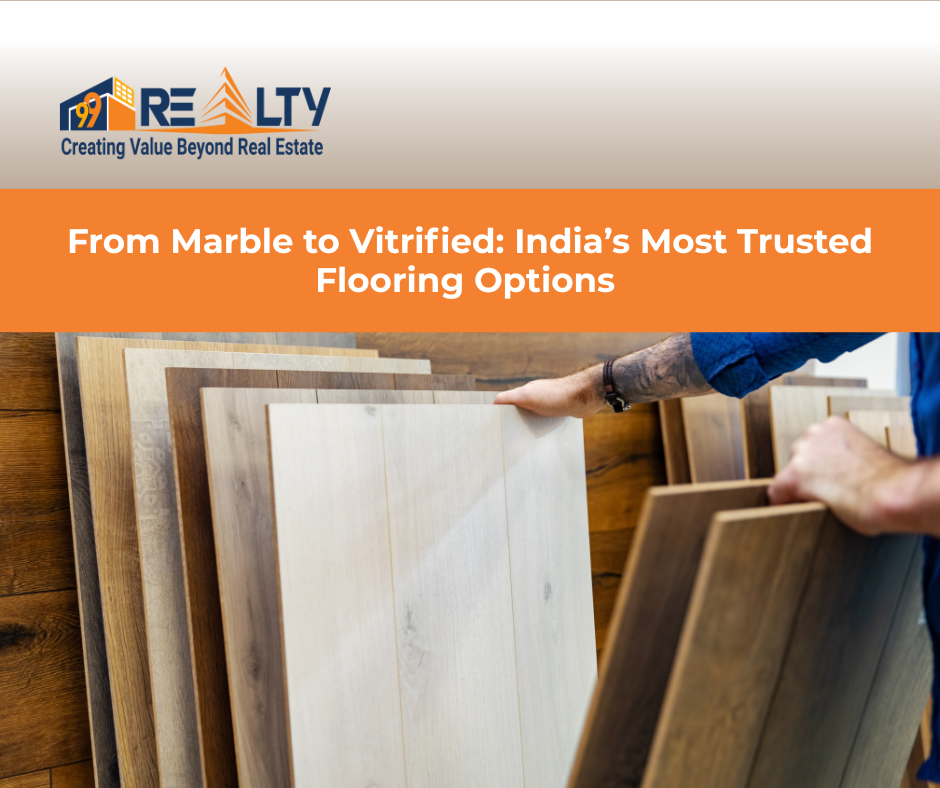When designing your dream home, flooring is often the unsung hero that quietly ties everything together.
It’s not just about looks—your choice of tile affects comfort, safety, maintenance, and even the value of your property.
If you’re planning a new home or a renovation, here’s your ultimate guide to understanding flooring tiles in India—curated by 99Realty, your trusted real estate knowledge partner.
Why Flooring Matters More Than You Think
Think of your floor as the stage where your life plays out every single day.
Whether it’s your child’s first steps, a family dinner, or your dog sprinting around the hall—your flooring takes it all.
In Indian homes, tiles are now replacing traditional stone and marble because they offer:
- Cleaner aesthetics
- Durability against heavy usage
- Climate adaptability
- Lower maintenance
- Endless design options
Ground vs. Top Floor Apartment : Which Is Best?
The Indian Flooring Landscape
India’s flooring market is thriving—projected to grow at 8–9% CAGR till 2028 (source: IBEF & Statista).
Thanks to rapid urbanisation, modern tile technology, and easy maintenance, homeowners are shifting from plain cement floors to ceramic, porcelain, and vitrified tiles.
Regional preferences also play a role:
- South India prefers cool vitrified or granite tiles for heat resistance.
- North India leans towards marble and textured tiles for warmth in winter.
- Urban metros like Mumbai, Delhi, and Bengaluru favour large-format glossy vitrified tiles.
- Tier-2 cities still use ceramic or mosaic tiles for affordability and charm.
Major Types of Flooring Tiles in India
Let’s decode the main tile types available in the Indian market today.
1. Ceramic Tiles

Made from clay and baked at high temperatures, ceramic tiles are the most affordable and popular option.
They come in glossy, matte, or textured finishes.
Pros:
- Budget-friendly (₹30–₹60 per sq. ft)
- Available in multiple designs and sizes
- Easy to install
Cons:
- Prone to cracks and chipping under heavy impact
- May absorb more water (not ideal for wet areas)
Best for: Bedrooms, living rooms, and walls.
2. Porcelain Tiles

Porcelain is a denser, more refined form of ceramic tile. It’s fired at higher temperatures, making it water- and stain-resistant.
Pros:
- Very durable and low-porosity
- Ideal for heavy traffic and moisture-prone areas
- Stain and scratch-resistant
Cons:
- Slightly costlier (₹70–₹120 per sq. ft)
- Requires expert installation
Best for: Living rooms, kitchens, and balconies.
3. Vitrified Tiles

A modern Indian favourite. These are made by mixing clay, silica, and quartz under extreme heat and pressure, resulting in a glass-like surface that’s tough and non-porous.
Variants:
- Double-charge vitrified: Durable, dual-layered finish.
- Full-body vitrified: Same colour throughout—scratches don’t show easily.
- Glazed vitrified: Printed designs with gloss/matte finish.
Pros:
- Highly water-resistant
- Long-lasting (15–25 years)
- Premium look, minimal maintenance
Cons:
- Costlier than ceramic (₹80–₹150 per sq. ft)
- Can be slippery in glossy finishes
Best for: Living rooms, corridors, offices.
4. Natural Stone & Marble Tiles

Marble is timeless and classy. Granite and limestone tiles are also popular in Indian luxury homes.
Pros:
- Adds elegance and resale value
- Naturally cool—great for warm climates
- Unique, natural patterns
Cons:
- Expensive (₹150–₹400 per sq. ft or more)
- Requires sealing and polishing after fitting
- Can stain and scratch easily
- The polish can wear off or get damaged when exposed to harsh detergents or strong floor cleaners.
Best for: Premium living spaces, foyers, temples, and villas.
5. Cement & Mosaic Tiles

The old-school heroes making a comeback. Cement and mosaic tiles are now being revived with artistic designs for heritage-style interiors.
The Backbone of Construction: How Bricks Define Quality and Durability
Pros:
- Eco-friendly and handcrafted
- Visually unique; adds vintage charm
- Non-slip and durable
Cons:
- Requires sealing and maintenance
- Limited design uniformity
Best for: Balconies, patios, cafes, heritage or artistic homes.
Tile Type Comparison Table
| Tile Type | Approx. Cost (₹/sq. ft) | Durability | Maintenance | Best Used In |
|---|---|---|---|---|
| Ceramic | 30–60 | Moderate | Easy | Bedrooms, Walls |
| Porcelain | 70–120 | High | Easy | Kitchens, Living Rooms |
| Vitrified | 80–150 | Very High | Low | Whole House |
| Marble/Stone | 150–400+ | Very High | High | Luxury Homes |
| Cement/Mosaic | 60–120 | Moderate | Moderate | Patios, Balconies |
Advantages of Using Tiles in Indian Homes
Durability: Long life span even in heavy traffic areas.
Aesthetic Variety: From wooden textures to marble-like finishes, endless options.
Climate Fit: Keeps homes cooler in summer.
Easy to Clean: Ideal for dust-prone Indian cities.
Budget Flexibility: Prices to suit every pocket.
Disadvantages & Practical Challenges
Cold Underfoot: Can feel chilly in winter regions.
Slippery When Wet: Especially glossy vitrified or marble tiles.
Chipping Risk: Poor installation or substandard quality leads to cracks.
Grout Issues: Dirty grout lines can dull the look.
Premium Cost for Luxury Tiles: Natural stone or designer vitrified can be pricey.
Always ask for anti-skid ratings (R9–R13) for bathroom and kitchen tiles.
Where to Use Which Type of Tile (Usability Guide)
| Room / Space | Recommended Tile Type | Finish |
|---|---|---|
| Living Room / Hall | Porcelain or Vitrified | Glossy / Matte |
| Bedroom | Ceramic or Glazed Vitrified | Matte |
| Bathroom | Anti-skid Ceramic / Mosaic | Rough |
| Kitchen | Porcelain / Glazed Vitrified | Matte |
| Balcony / Outdoor | Cement / Textured Vitrified | Textured |
| Luxury Spaces | Marble / Full-body Vitrified | Polished |
Maintenance, Cleaning & Lifespan Tips
- Sweep and mop daily with mild detergent.
- Avoid acid-based cleaners on marble or cement tiles.
- Use mats at entrances to reduce dust.
- Re-seal stone tiles every 2–3 years.
- Replace broken tiles immediately to prevent seepage.
Properly installed vitrified or porcelain tiles can last 20–30 years with minimal maintenance.
How to Choose the Right Tile for Your Home
Before you hit the showroom, check this quick buyer’s checklist:
- Define your budget and area size.
- Choose tile type based on usage & traffic.
- Check slip resistance, thickness, and water absorption.
- Match colour tone with your room’s lighting.
- Always ask for extra tiles (5–10%) for future replacements.
- Hire experienced installers—good laying matters more than brand.
99 Realty’s Take – Flooring That Adds Real Value
At 99Realty, we believe good flooring is more than decoration—it’s an investment.
A well-chosen floor increases your home’s visual appeal, safety, and resale value.
Whether you’re building, buying, or renovating, always plan flooring with the same care as your layout and lighting.
Our team regularly updates the 99Realty Blog to guide you on everything from property trends to interior finishing so you can make confident, well-informed decisions.
🏠 Looking for the perfect home with premium features? Explore verified listings and property insights only on 99 Realty
Conclusion
Flooring may be beneath your feet, but it deserves to be top of your mind.
Tiles aren’t just about design—they define your comfort, durability, and lifestyle.
By understanding the advantages, disadvantages, and proper usage of each type, you can pick flooring that fits both your space and your story.
With a little research and guidance from 99Realty, your dream floor—and dream home—are well within reach.
Need Help?
Need help evaluating a property or planning your next move in the market?
Reach out to 99 REALTY – your trusted real estate partner for smarter choices.
Subscribe to get updates on our latest posts and market trends.






Join The Discussion